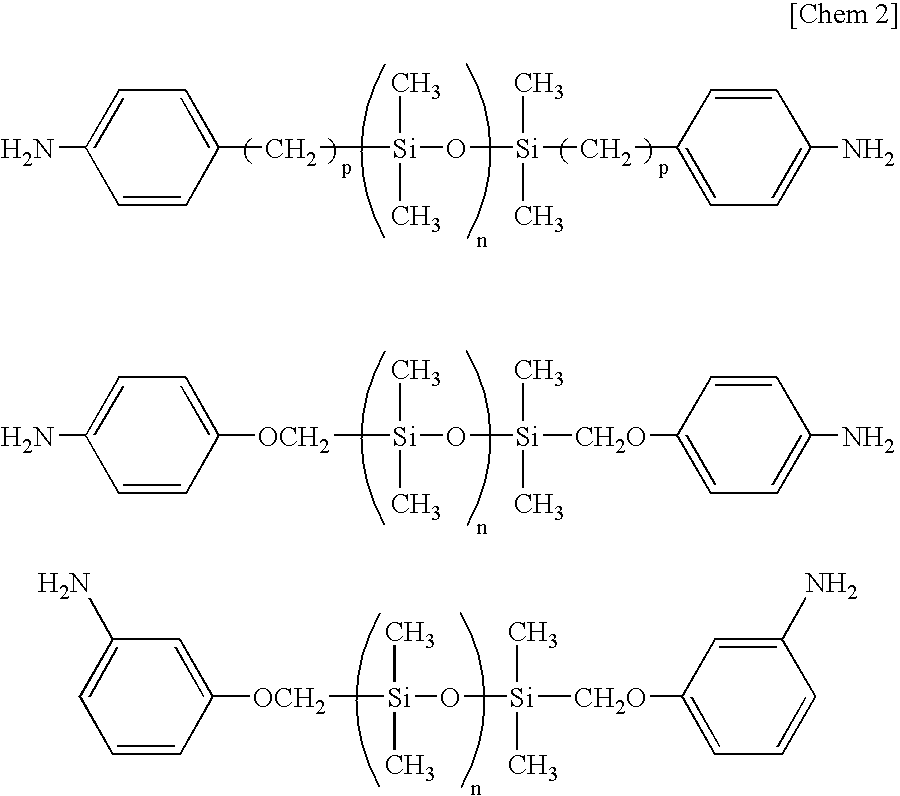Block Copolymerized Polyimide Ink Composition for Printing
a polyimide and composition technology, applied in the direction of printed circuit, ink, non-metallic protective coating application, etc., can solve the problems of high temperature and high, high cost, and long treatment time, and achieve low modulus of elasticity, high elongation, and strong adhesion
- Summary
- Abstract
- Description
- Claims
- Application Information
AI Technical Summary
Benefits of technology
Problems solved by technology
Method used
Image
Examples
synthesis example 1
[0044]To a 3-liter three-necked separable flask to which a stainless steel anchor agitator is attached, a condenser comprising a trap for separation of water and a cooling tube having balls, is attached. To the flask, 882.67 g (3000 mmol) of 3,3′,4,4′-biphenyltetracarboxylic dianhydride (BPDA), 1876.00 g (2000 mmol) of diaminosiloxane compound BY16-853U (amino equivalent: 469) produced by Dow Corning Toray, 30.03 g (300 mmol) of γ-valerolactone, 47.46 g (600 mmol) of pyridine, 1200 g of triglyme, 1200 g of ethyl benzoate and 400 g of toluene are fed. After stirring the mixture at room temperature under a nitrogen atmosphere at 180 rpm for 30 minutes, the temperature was raised to 180° C. and the mixture was stirred for 1 hour. During the reaction, toluene-water azeotrope was removed.
[0045]After cooling the mixture to room temperature, 146.17 g (500 mmol) of 1,3-bis(3-aminophenoxy)benzene (APB), 146.17 g (500 mmol) of m-bis(4-aminophenoxy)benzene and 598 g of triglyme were fed, and 5...
synthesis example 2
[0046]To a 2-liter three-necked separable flask to which a stainless steel anchor agitator is attached, a condenser comprising a trap for separation of water and a cooling tube having balls, is attached. To the flask, 111.68 g (360 mmol) of bis-(3,4-dicarboxyphenyl)ether dianhydride (ODPA), 165.24 g (180 mmol) of diaminosiloxane compound BY16-853U (amino equivalent: 459) produced by Dow Corning Toray, 4.33 g (43 mmol) of γ-valerolactone, 6.83 g (86 mmol) of pyridine, 168 g of ethyl benzoate, 168 g of triglyme and 60 g of toluene are fed. After stirring the mixture at room temperature under a nitrogen atmosphere at 180 rpm for 30 minutes, the temperature was raised to 180° C. and the mixture was stirred for 1 hour. During the reaction, toluene-water azeotrope was removed.
[0047]After cooling the mixture to room temperature, 22.34 g (72 mmol) of bis-(3,4-dicarboxyphenyl)ether dianhydride (ODPA), 63.15 g (216 mmol) of 1,3-bis(3-aminophenoxy)benzene, 10.52 g (36 mmol) of 1,3-bis(4-aminop...
synthesis example 3
[0049]ODPA in an amount of 31.02 g (100 mmol), 93.00 g (100 mmol) of diaminosiloxane compound KF-8010 (amino equivalent: 415) produced by Shin-Etsu Chemical, 14.31 g (75 mmol) of 3,3′-dicarboxy-4,4′-diaminodiphenylmethane, 3.75 g (37.5 mmol) of γ-valerolactone, 5.93 g (50 mmol) of pyridine, 120 g of ethyl benzoate, 120 g of triglyme and 60 g of toluene are fed. After stirring the mixture at room temperature under a nitrogen atmosphere at 180 rpm for 30 minutes, the temperature was raised to 180° C. and the mixture was stirred for 1 hour. During the reaction, toluene-water azeotrope was removed.
[0050]After cooling the mixture to room temperature, 71.66 g (200 mmol) of 3,3′,4,4′-biphenylsulfonetetracarboxylic dianhydride, 61.58 g (150 mmol) of 2,2-bis[4-(4-aminophenoxy)phenyl]propane, 75 g of ethyl benzoate, 75 g of triglyme and 60 g of toluene were added, and the mixture was allowed to react at 180° C. for 5 hours with stirring at 180 rpm. By removing the refluxed material from the s...
PUM
| Property | Measurement | Unit |
|---|---|---|
| particle size | aaaaa | aaaaa |
| temperature | aaaaa | aaaaa |
| temperature | aaaaa | aaaaa |
Abstract
Description
Claims
Application Information
 Login to View More
Login to View More - R&D
- Intellectual Property
- Life Sciences
- Materials
- Tech Scout
- Unparalleled Data Quality
- Higher Quality Content
- 60% Fewer Hallucinations
Browse by: Latest US Patents, China's latest patents, Technical Efficacy Thesaurus, Application Domain, Technology Topic, Popular Technical Reports.
© 2025 PatSnap. All rights reserved.Legal|Privacy policy|Modern Slavery Act Transparency Statement|Sitemap|About US| Contact US: help@patsnap.com



